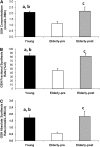Deficient synthesis of glutathione underlies oxidative stress in aging and can be corrected by dietary cysteine and glycine supplementation
- PMID: 21795440
- PMCID: PMC3155927
- DOI: 10.3945/ajcn.110.003483
Deficient synthesis of glutathione underlies oxidative stress in aging and can be corrected by dietary cysteine and glycine supplementation
Abstract
Background: Aging is associated with oxidative stress, but underlying mechanisms remain poorly understood.
Objective: We tested whether glutathione deficiency occurs because of diminished synthesis and contributes to oxidative stress in aging and whether stimulating glutathione synthesis with its precursors cysteine and glycine could alleviate oxidative stress.
Design: Eight elderly and 8 younger subjects received stable-isotope infusions of [2H(2)]glycine, after which red blood cell (RBC) glutathione synthesis and concentrations, plasma oxidative stress, and markers of oxidant damage (eg, F(2)-isoprostanes) were measured. Elderly subjects were restudied after 2 wk of glutathione precursor supplementation.
Results: Compared with younger control subjects, elderly subjects had markedly lower RBC concentrations of glycine (486.7 ± 28.3 compared with 218.0 ± 23.7 μmol/L; P < 0.01), cysteine (26.2 ± 1.4 compared with 19.8 ± 1.3 μmol/L; P < 0.05), and glutathione (2.08 ± 0.12 compared with 1.12 ± 0.18 mmol/L RBCs; P < 0.05); lower glutathione fractional (83.14 ± 6.43% compared with 45.80 ± 5.69%/d; P < 0.01) and absolute (1.73 ± 0.16 compared with 0.55 ± 0.12 mmol/L RBCs per day; P < 0.01) synthesis rates; and higher plasma oxidative stress (304 ± 16 compared with 346 ± 20 Carratelli units; P < 0.05) and plasma F(2)-isoprostanes (97.7 ± 8.3 compared with 136.3 ± 11.3 pg/mL; P < 0.05). Precursor supplementation in elderly subjects led to a 94.6% higher glutathione concentration, a 78.8% higher fractional synthesis rate, a 230.9% higher absolute synthesis rate, and significantly lower plasma oxidative stress and F(2)-isoprostanes. No differences in these measures were observed between younger subjects and supplemented elderly subjects.
Conclusions: Glutathione deficiency in elderly humans occurs because of a marked reduction in synthesis. Dietary supplementation with the glutathione precursors cysteine and glycine fully restores glutathione synthesis and concentrations and lowers levels of oxidative stress and oxidant damages. These findings suggest a practical and effective approach to decreasing oxidative stress in aging.
Figures

Similar articles
-
Glutathione synthesis is diminished in patients with uncontrolled diabetes and restored by dietary supplementation with cysteine and glycine.Diabetes Care. 2011 Jan;34(1):162-7. doi: 10.2337/dc10-1006. Epub 2010 Oct 7. Diabetes Care. 2011. PMID: 20929994 Free PMC article.
-
Substitution of Dietary Sulfur Amino Acids by dl-2-Hydroxy-4-Methylthiobutyric Acid Reduces Fractional Glutathione Synthesis in Weaned Piglets.J Nutr. 2020 Apr 1;150(4):722-729. doi: 10.1093/jn/nxz272. J Nutr. 2020. PMID: 31773161 Free PMC article.
-
In vivo rates of erythrocyte glutathione synthesis in adults with sickle cell disease.Am J Physiol Endocrinol Metab. 2006 Jul;291(1):E73-9. doi: 10.1152/ajpendo.00287.2005. Epub 2006 Jan 24. Am J Physiol Endocrinol Metab. 2006. PMID: 16434557
-
An increased need for dietary cysteine in support of glutathione synthesis may underlie the increased risk for mortality associated with low protein intake in the elderly.Age (Dordr). 2015 Oct;37(5):96. doi: 10.1007/s11357-015-9823-8. Epub 2015 Sep 11. Age (Dordr). 2015. PMID: 26362762 Free PMC article. Review.
-
GlyNAC Supplementation Improves Glutathione Deficiency, Oxidative Stress, Mitochondrial Dysfunction, Inflammation, Aging Hallmarks, Metabolic Defects, Muscle Strength, Cognitive Decline, and Body Composition: Implications for Healthy Aging.J Nutr. 2021 Dec 3;151(12):3606-3616. doi: 10.1093/jn/nxab309. J Nutr. 2021. PMID: 34587244 Review.
Cited by
-
Retracted Article: Structural characterization of peptides from Locusta migratoria manilensis (Meyen, 1835) and anti-aging effect in Caenorhabditis elegans.RSC Adv. 2019 Mar 21;9(16):9289-9300. doi: 10.1039/c9ra00089e. eCollection 2019 Mar 15. RSC Adv. 2019. Retraction in: RSC Adv. 2022 Apr 28;12(19):11605. doi: 10.1039/d2ra90038f. PMID: 35517704 Free PMC article. Retracted.
-
Oxidative Stress in Plasma from Patients with Marfan Syndrome Is Modulated by Deodorized Garlic Preliminary Findings.Oxid Med Cell Longev. 2022 Jan 17;2022:5492127. doi: 10.1155/2022/5492127. eCollection 2022. Oxid Med Cell Longev. 2022. PMID: 35082968 Free PMC article.
-
Functional Foods and Nutraceuticals for the Management of Cardiovascular Disease Risk in Postmenopausal Women.Rev Cardiovasc Med. 2024 Dec 25;25(12):460. doi: 10.31083/j.rcm2512460. eCollection 2024 Dec. Rev Cardiovasc Med. 2024. PMID: 39742223 Free PMC article. Review.
-
Ferroptosis and Neurodegenerative Diseases: Insights into the Regulatory Roles of SLC7A11.Cell Mol Neurobiol. 2023 Aug;43(6):2627-2642. doi: 10.1007/s10571-023-01343-7. Epub 2023 Mar 29. Cell Mol Neurobiol. 2023. PMID: 36988772 Free PMC article. Review.
-
Presence of chronic morbidities alters skeletal muscle health and amino acid kinetics in mild cognitive impairment.J Alzheimers Dis. 2025 Jun;105(4):1413-1431. doi: 10.1177/13872877251336618. Epub 2025 May 4. J Alzheimers Dis. 2025. PMID: 40320781 Free PMC article.
References
-
- Campisi A, Di Giacomo C, Russo A, Sorrenti V, Vanella G, Acquaviva R, Li Volti G, Vanella A. Antioxidant systems in rat lens as a function of age: effect of chronic administration of vitamin E and ascorbate. Aging (Milano) 1999;11:39–43 - PubMed
-
- Castorina C, Campisi A, Di Giacomo C, Sorrenti V, Russo A, Vanella A. Lipid peroxidation and antioxidant enzymatic systems in rat retina as a function of age. Neurochem Res 1992;17:599–604 - PubMed
-
- Sweeney MH, Truscott RJ. An impediment to glutathione diffusion in older normal human lenses: a possible precondition for nuclear cataract. Exp Eye Res 1998;67:587–95 - PubMed
-
- Samiec PS, Drews-Botsch C, Flagg EW, Kurtz JC, Sternberg P Jr, Reed RL, Jones DP. Glutathione in human plasma: decline in association with aging, age-related macular degeneration, and diabetes. Free Radic Biol Med 1998;24:699–704 - PubMed
Publication types
MeSH terms
Substances
Grants and funding
LinkOut - more resources
Full Text Sources
Other Literature Sources
Medical

